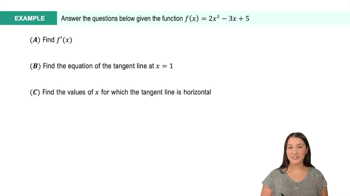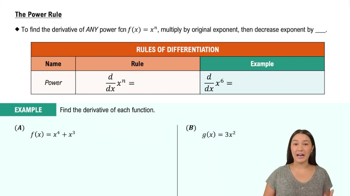Table of contents
- 0. Functions7h 52m
- Introduction to Functions16m
- Piecewise Functions10m
- Properties of Functions9m
- Common Functions1h 8m
- Transformations5m
- Combining Functions27m
- Exponent rules32m
- Exponential Functions28m
- Logarithmic Functions24m
- Properties of Logarithms34m
- Exponential & Logarithmic Equations35m
- Introduction to Trigonometric Functions38m
- Graphs of Trigonometric Functions44m
- Trigonometric Identities47m
- Inverse Trigonometric Functions48m
- 1. Limits and Continuity2h 2m
- 2. Intro to Derivatives1h 33m
- 3. Techniques of Differentiation3h 18m
- 4. Applications of Derivatives2h 38m
- 5. Graphical Applications of Derivatives6h 2m
- 6. Derivatives of Inverse, Exponential, & Logarithmic Functions2h 37m
- 7. Antiderivatives & Indefinite Integrals1h 26m
3. Techniques of Differentiation
Basic Rules of Differentiation
Problem 3.43b
Textbook Question
City urbanization City planners model the size of their city using the function A(t) = - 1/50t² + 2t +20, for 0 ≤ t ≤ 50, where A is measured in square miles and t is the number of years after 2010.
b. How fast will the city be growing when it reaches a size of 38 mi²?
 Verified step by step guidance
Verified step by step guidance1
Step 1: Identify the function A(t) = -\frac{1}{50}t^2 + 2t + 20, which models the size of the city in square miles as a function of time t in years after 2010.
Step 2: To find how fast the city is growing, we need to determine the rate of change of A with respect to t, which is the derivative A'(t).
Step 3: Differentiate A(t) with respect to t to find A'(t). The derivative of A(t) = -\frac{1}{50}t^2 + 2t + 20 is A'(t) = -\frac{2}{50}t + 2.
Step 4: Set A(t) equal to 38 to find the value of t when the city reaches a size of 38 mi². Solve the equation -\frac{1}{50}t^2 + 2t + 20 = 38 for t.
Step 5: Once you have the value of t, substitute it into A'(t) to find the rate of growth of the city at that time.
Recommended similar problem, with video answer:
 Verified Solution
Verified SolutionThis video solution was recommended by our tutors as helpful for the problem above
Video duration:
6mPlay a video:
Was this helpful?

 3:59m
3:59mWatch next
Master Derivatives of Linear Functions with a bite sized video explanation from Callie
Start learningRelated Videos
Related Practice







